flat tire JEEP COMPASS 2012 1.G User Guide
[x] Cancel search | Manufacturer: JEEP, Model Year: 2012, Model line: COMPASS, Model: JEEP COMPASS 2012 1.GPages: 108, PDF Size: 4.03 MB
Page 65 of 108
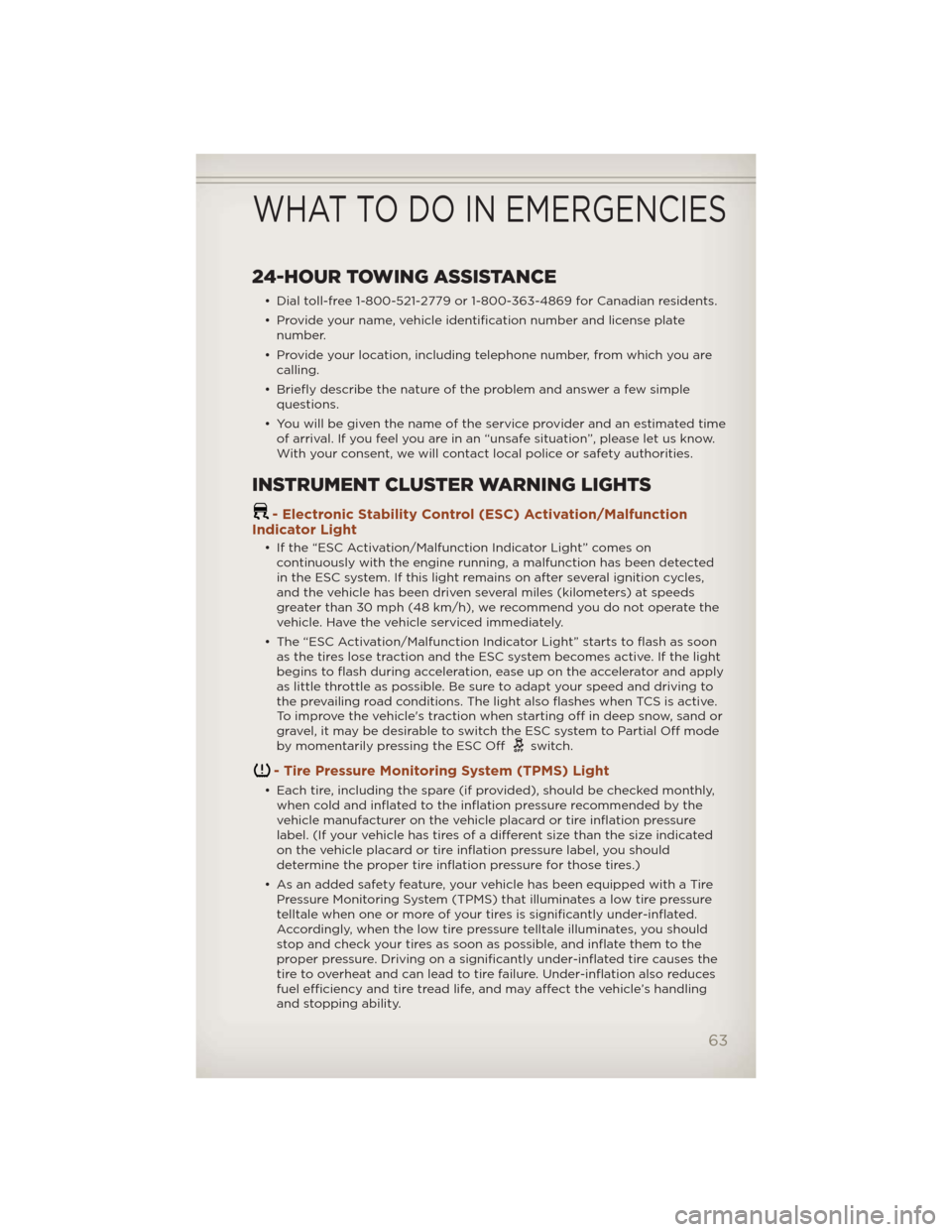
24-HOUR TOWING ASSISTANCE
• Dial toll-free 1-800-521-2779 or 1-800-363-4869 for Canadian residents.
• Provide your name, vehicle identification number and license plate
number.
• Provide your location, including telephone number, from which you are
calling.
• Briefly describe the nature of the problem and answer a few simple
questions.
• You will be given the name of the service provider and an estimated time
of arrival. If you feel you are in an “unsafe situation”, please let us know.
With your consent, we will contact local police or safety authorities.
INSTRUMENT CLUSTER WARNING LIGHTS
- Electronic Stability Control (ESC) Activation/Malfunction
Indicator Light
• If the “ESC Activation/Malfunction Indicator Light” comes on
continuously with the engine running, a malfunction has been detected
in the ESC system. If this light remains on after several ignition cycles,
and the vehicle has been driven several miles (kilometers) at speeds
greater than 30 mph (48 km/h), we recommend you do not operate the
vehicle. Have the vehicle serviced immediately.
• The “ESC Activation/Malfunction Indicator Light” starts to flash as soon
as the tires lose traction and the ESC system becomes active. If the light
begins to flash during acceleration, ease up on the accelerator and apply
as little throttle as possible. Be sure to adapt your speed and driving to
the prevailing road conditions. The light also flashes when TCS is active.
To improve the vehicle's traction when starting off in deep snow, sand or
gravel, it may be desirable to switch the ESC system to Partial Off mode
by momentarily pressing the ESC Off
switch.
- Tire Pressure Monitoring System (TPMS) Light
• Each tire, including the spare (if provided), should be checked monthly,
when cold and inflated to the inflation pressure recommended by the
vehicle manufacturer on the vehicle placard or tire inflation pressure
label. (If your vehicle has tires of a different size than the size indicated
on the vehicle placard or tire inflation pressure label, you should
determine the proper tire inflation pressure for those tires.)
• As an added safety feature, your vehicle has been equipped with a Tire
Pressure Monitoring System (TPMS) that illuminates a low tire pressure
telltale when one or more of your tires is significantly under-inflated.
Accordingly, when the low tire pressure telltale illuminates, you should
stop and check your tires as soon as possible, and inflate them to the
proper pressure. Driving on a significantly under-inflated tire causes the
tire to overheat and can lead to tire failure. Under-inflation also reduces
fuel efficiency and tire tread life, and may affect the vehicle’s handling
and stopping ability.
WHAT TO DO IN EMERGENCIES
63
Page 66 of 108
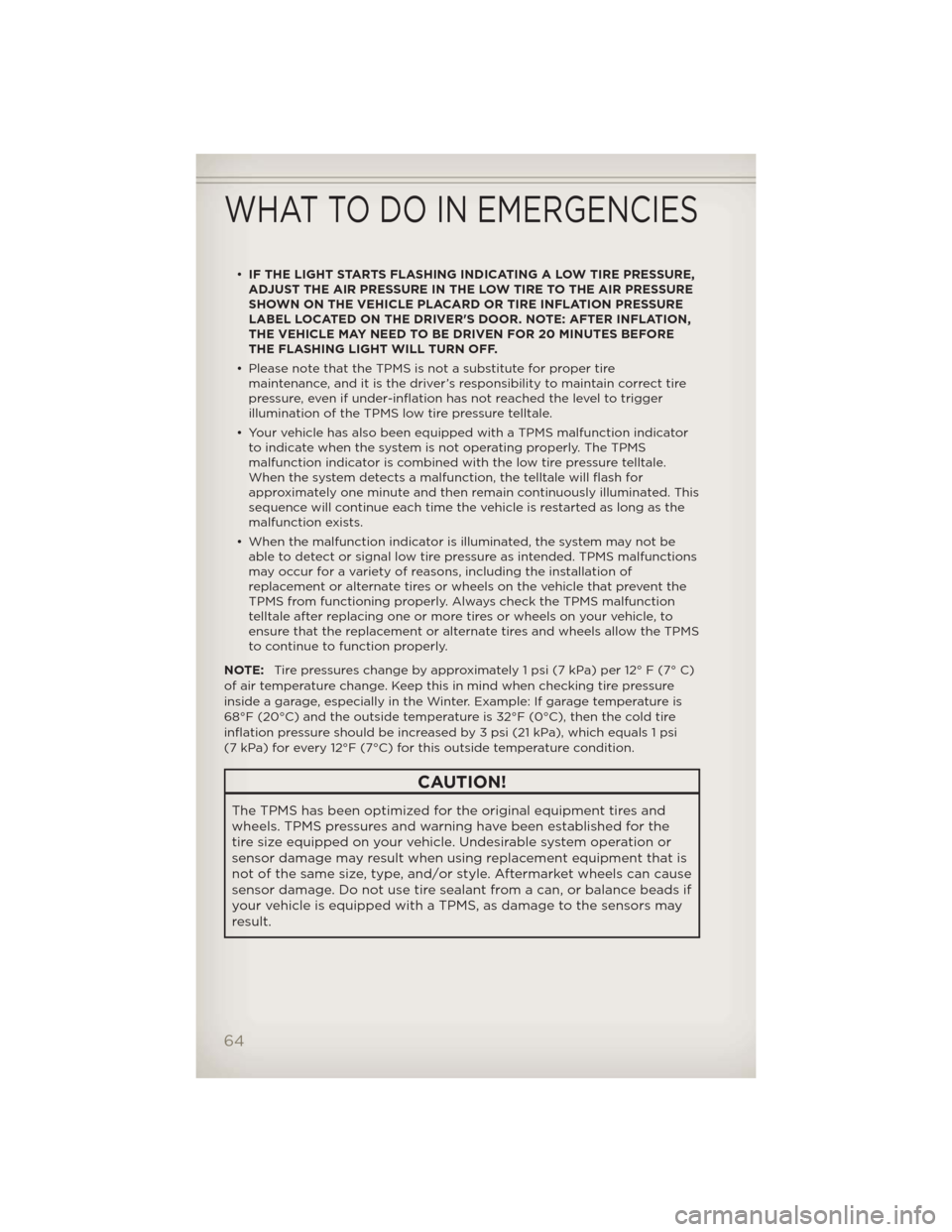
•IF THE LIGHT STARTS FLASHING INDICATING A LOW TIRE PRESSURE,
ADJUST THE AIR PRESSURE IN THE LOW TIRE TO THE AIR PRESSURE
SHOWN ON THE VEHICLE PLACARD OR TIRE INFLATION PRESSURE
LABEL LOCATED ON THE DRIVER'S DOOR. NOTE: AFTER INFLATION,
THE VEHICLE MAY NEED TO BE DRIVEN FOR 20 MINUTES BEFORE
THE FLASHING LIGHT WILL TURN OFF.
• Please note that the TPMS is not a substitute for proper tire
maintenance, and it is the driver’s responsibility to maintain correct tire
pressure, even if under-inflation has not reached the level to trigger
illumination of the TPMS low tire pressure telltale.
• Your vehicle has also been equipped with a TPMS malfunction indicator
to indicate when the system is not operating properly. The TPMS
malfunction indicator is combined with the low tire pressure telltale.
When the system detects a malfunction, the telltale will flash for
approximately one minute and then remain continuously illuminated. This
sequence will continue each time the vehicle is restarted as long as the
malfunction exists.
• When the malfunction indicator is illuminated, the system may not be
able to detect or signal low tire pressure as intended. TPMS malfunctions
may occur for a variety of reasons, including the installation of
replacement or alternate tires or wheels on the vehicle that prevent the
TPMS from functioning properly. Always check the TPMS malfunction
telltale after replacing one or more tires or wheels on your vehicle, to
ensure that the replacement or alternate tires and wheels allow the TPMS
to continue to function properly.
NOTE:Tire pressures change by approximately 1 psi (7 kPa) per 12° F (7° C)
of air temperature change. Keep this in mind when checking tire pressure
inside a garage, especially in the Winter. Example: If garage temperature is
68°F (20°C) and the outside temperature is 32°F (0°C), then the cold tire
inflation pressure should be increased by 3 psi (21 kPa), which equals 1 psi
(7 kPa) for every 12°F (7°C) for this outside temperature condition.
CAUTION!
The TPMS has been optimized for the original equipment tires and
wheels. TPMS pressures and warning have been established for the
tire size equipped on your vehicle. Undesirable system operation or
sensor damage may result when using replacement equipment that is
not of the same size, type, and/or style. Aftermarket wheels can cause
sensor damage. Do not use tire sealant from a can, or balance beads if
your vehicle is equipped with a TPMS, as damage to the sensors may
result.
WHAT TO DO IN EMERGENCIES
64
Page 73 of 108
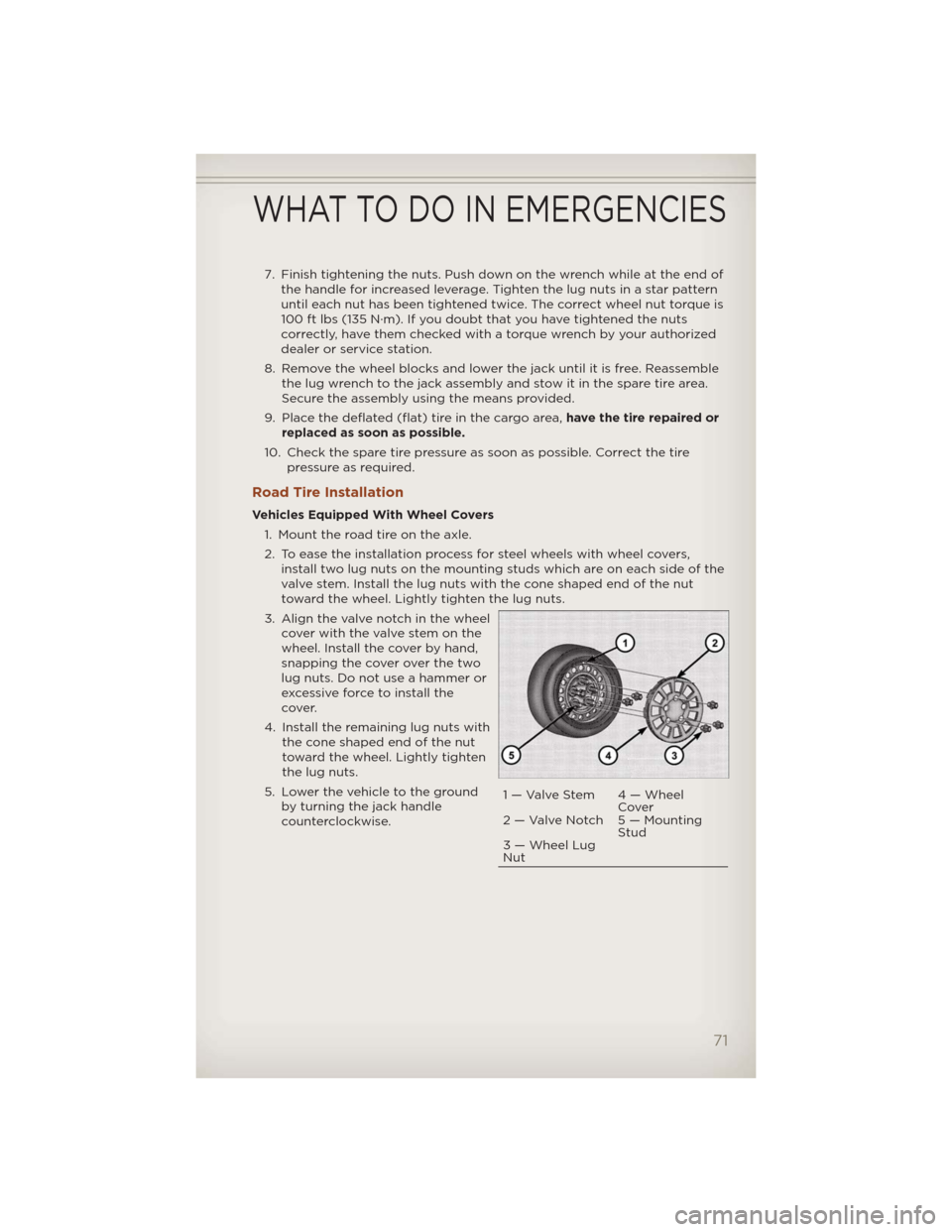
7. Finish tightening the nuts. Push down on the wrench while at the end of
the handle for increased leverage. Tighten the lug nuts in a star pattern
until each nut has been tightened twice. The correct wheel nut torque is
100 ft lbs (135 N·m). If you doubt that you have tightened the nuts
correctly, have them checked with a torque wrench by your authorized
dealer or service station.
8. Remove the wheel blocks and lower the jack until it is free. Reassemble
the lug wrench to the jack assembly and stow it in the spare tire area.
Secure the assembly using the means provided.
9. Place the deflated (flat) tire in the cargo area,have the tire repaired or
replaced as soon as possible.
10. Check the spare tire pressure as soon as possible. Correct the tire
pressure as required.
Road Tire Installation
Vehicles Equipped With Wheel Covers
1. Mount the road tire on the axle.
2. To ease the installation process for steel wheels with wheel covers,
install two lug nuts on the mounting studs which are on each side of the
valve stem. Install the lug nuts with the cone shaped end of the nut
toward the wheel. Lightly tighten the lug nuts.
3. Align the valve notch in the wheel
cover with the valve stem on the
wheel. Install the cover by hand,
snapping the cover over the two
lug nuts. Do not use a hammer or
excessive force to install the
cover.
4. Install the remaining lug nuts with
the cone shaped end of the nut
toward the wheel. Lightly tighten
the lug nuts.
5. Lower the vehicle to the ground
by turning the jack handle
counterclockwise.
1 — Valve Stem 4 — Wheel
Cover
2 — Valve Notch 5 — Mounting
Stud
3 — Wheel Lug
Nut
WHAT TO DO IN EMERGENCIES
71
Page 75 of 108
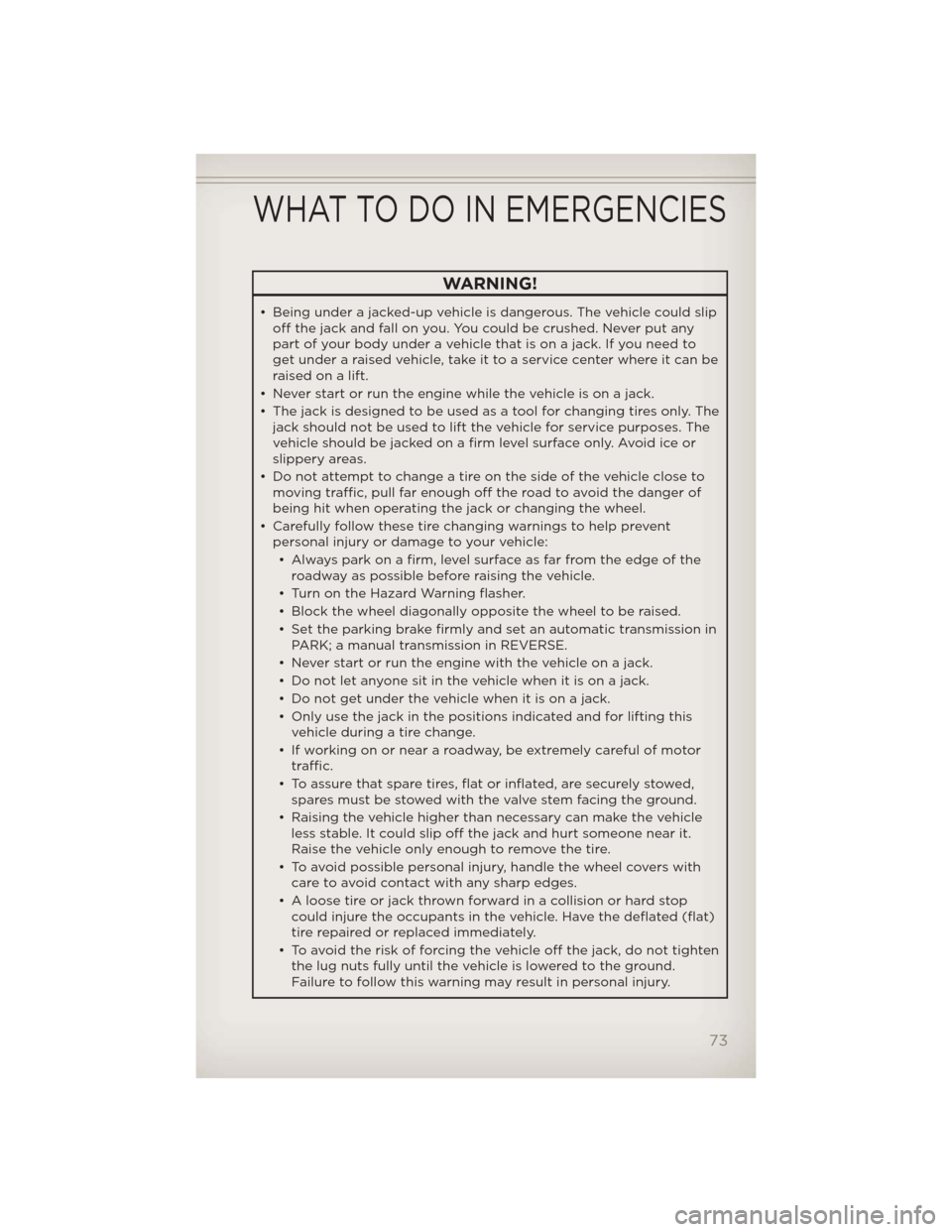
WARNING!
• Being under a jacked-up vehicle is dangerous. The vehicle could slip
off the jack and fall on you. You could be crushed. Never put any
part of your body under a vehicle that is on a jack. If you need to
get under a raised vehicle, take it to a service center where it can be
raised on a lift.
• Never start or run the engine while the vehicle is on a jack.
• The jack is designed to be used as a tool for changing tires only. The
jack should not be used to lift the vehicle for service purposes. The
vehicle should be jacked on a firm level surface only. Avoid ice or
slippery areas.
• Do not attempt to change a tire on the side of the vehicle close to
moving traffic, pull far enough off the road to avoid the danger of
being hit when operating the jack or changing the wheel.
• Carefully follow these tire changing warnings to help prevent
personal injury or damage to your vehicle:
• Alwayspark on a firm, level surface as far from the edge of the
roadway as possible before raising the vehicle.
• Turn on the Hazard Warning flasher.
• Block the wheel diagonally opposite the wheel to be raised.
• Set the parking brake firmly and set an automatic transmission in
PARK; a manual transmission in REVERSE.
• Never start or run the engine with the vehicle on a jack.
• Do not let anyone sit in the vehicle when it is on a jack.
• Do not get under the vehicle when it is on a jack.
• Only use the jack in the positions indicated and for lifting this
vehicle during a tire change.
• If working on or near a roadway, be extremely careful of motor
traffic.
• To assure that spare tires, flat or inflated, are securely stowed,
spares must be stowed with the valve stem facing the ground.
• Raising the vehicle higher than necessary can make the vehicle
less stable. It could slip off the jack and hurt someone near it.
Raise the vehicle only enough to remove the tire.
• To avoid possible personal injury, handle the wheel covers with
care to avoid contact with any sharp edges.
• A loose tire or jack thrown forward in a collision or hard stop
could injure the occupants in the vehicle. Have the deflated (flat)
tire repaired or replaced immediately.
• To avoid the risk of forcing the vehicle off the jack, do not tighten
the lug nuts fully until the vehicle is lowered to the ground.
Failure to follow this warning may result in personal injury.
WHAT TO DO IN EMERGENCIES
73
Page 91 of 108
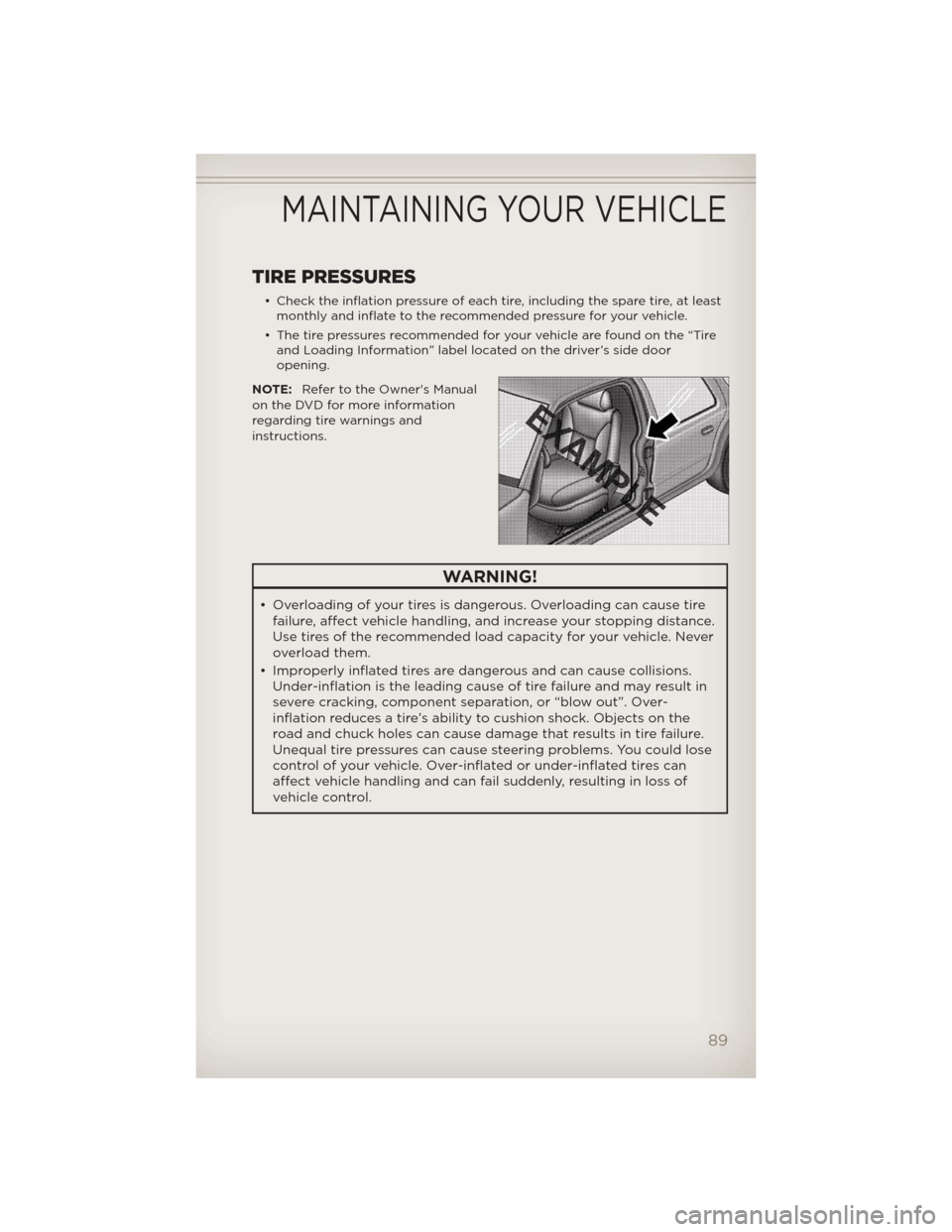
TIRE PRESSURES
• Check the inflation pressure of each tire, including the spare tire, at least
monthly and inflate to the recommended pressure for your vehicle.
• The tire pressures recommended for your vehicle are found on the “Tire
and Loading Information” label located on the driver’s side door
opening.
NOTE:Refer to the Owner's Manual
on the DVD for more information
regarding tire warnings and
instructions.
WARNING!
• Overloading of your tires is dangerous. Overloading can cause tire
failure, affect vehicle handling, and increase your stopping distance.
Use tires of the recommended load capacity for your vehicle. Never
overload them.
• Improperly inflated tires are dangerous and can cause collisions.
Under-inflation is the leading cause of tire failure and may result in
severe cracking, component separation, or “blow out”. Over-
inflation reduces a tire’s ability to cushion shock. Objects on the
road and chuck holes can cause damage that results in tire failure.
Unequal tire pressures can cause steering problems. You could lose
control of your vehicle. Over-inflated or under-inflated tires can
affect vehicle handling and can fail suddenly, resulting in loss of
vehicle control.
MAINTAINING YOUR VEHICLE
89
Page 96 of 108
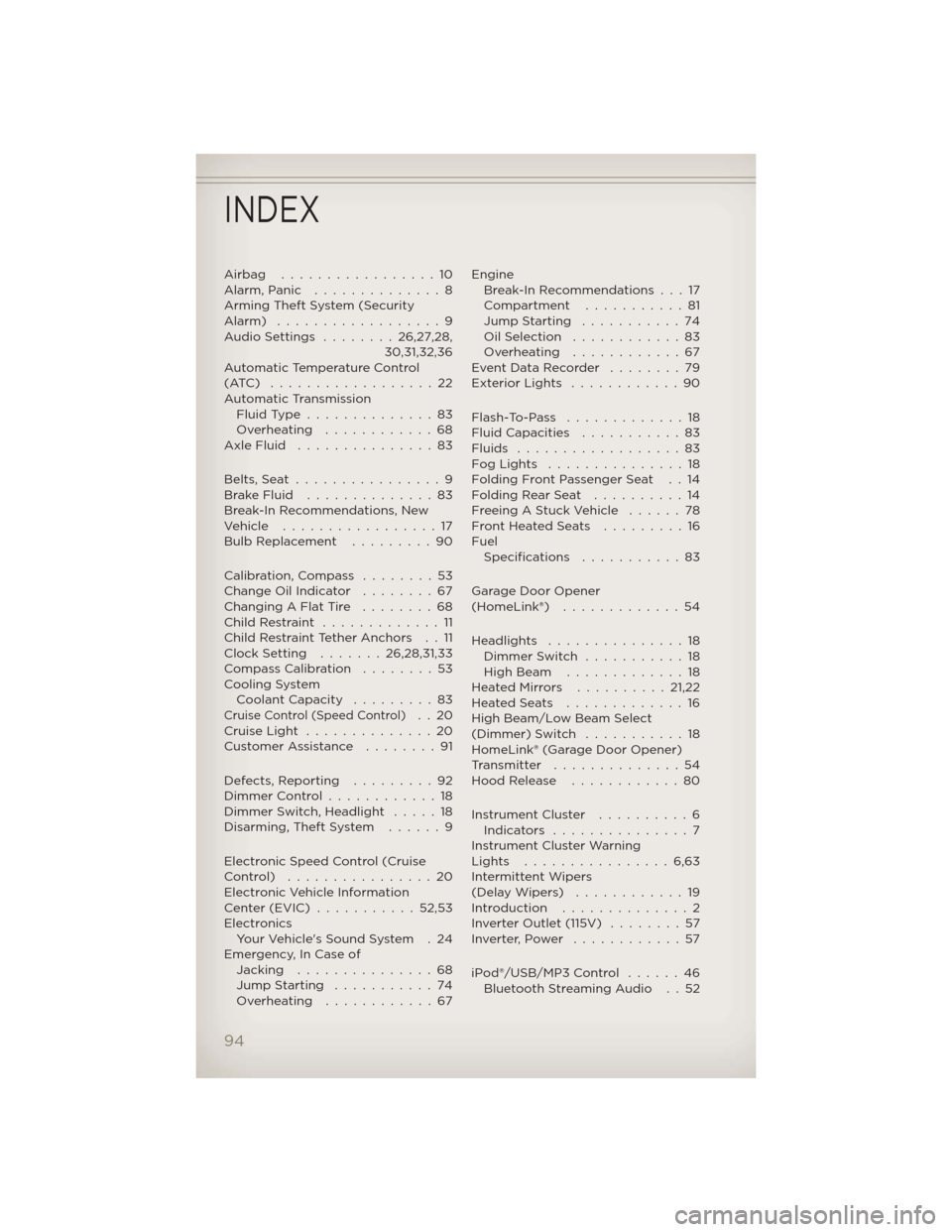
Airbag .................10
Alarm,Panic ..............8
Arming Theft System (Security
Alarm) ..................9
AudioSettings ........26,27,28,
30,31,32,36
Automatic Temperature Control
(ATC) ..................22
Automatic Transmission
FluidType..............83
Overheating ............68
AxleFluid ...............83
Belts, Seat................9
BrakeFluid ..............83
Break-In Recommendations, New
Vehicle .................17
Bulb Replacement.........90
Calibration, Compass........53
Change Oil Indicator........67
Changing A Flat Tire........68
ChildRestraint .............11
Child Restraint Tether Anchors . . 11
Clock Setting.......26,28,31,33
Compass Calibration........53
Cooling System
Coolant Capacity.........83
Cruise Control (Speed Control)..20
CruiseLight ..............20
Customer Assistance........91
Defects, Reporting.........92
Dimmer Control............18
Dimmer Switch, Headlight.....18
Disarming, Theft System . . . . . . 9
Electronic Speed Control (Cruise
Control) ................20
Electronic Vehicle Information
Center(EVIC) ...........52,53
Electronics
Your Vehicle's Sound System . 24
Emergency, In Case of
Jacking...............68
Jump Starting...........74
Overheating ............67Engine
Break-In Recommendations . . . 17
Compartment . . . . . . . . . . . 81
Jump Starting...........74
OilSelection ............83
Overheating ............67
Event Data Recorder . . . . . . . . 79
Exterior Lights . . . . . . . . . . . . 90
Flash-To-Pass .............18
Fluid Capacities . . . . . . . . . . . 83
Fluids ..................83
FogLights ...............18
Folding Front Passenger Seat . . 14
FoldingRearSeat ..........14
Freeing A Stuck Vehicle . . . . . . 78
Front Heated Seats . . . . . . . . . 16
Fuel
Specifications . . . . . . .....83
Garage Door Opener
(HomeLink®) . . ...........54
Headlights . . . . . . . . . . . . . . . 18
Dimmer Switch . . . . . . . . . . . 18
High Beam . . . . . . . . . . . . . 18
HeatedMirrors ..........21,22
HeatedSeats .............16
High Beam/Low Beam Select
(Dimmer) Switch . . . . . . . . . . . 18
HomeLink® (Garage Door Opener)
Transmitter . . . . . . . . . . . . . . 54
Hood Release . . . . . . . . . . . . 80
Instrument Cluster . . . . . . . . . . 6
Indicators ...............7
Instrument Cluster Warning
Lights ................6,63
Intermittent Wipers
(DelayWipers) ............19
Introduction . . . . . . . . ......2
Inverter Outlet (115V) . . . . . . . . 57
Inverter,Power ............57
iPod®/USB/MP3 Control . . . . . . 46
Bluetooth Streaming Audio . . 52
INDEX
94
Page 99 of 108
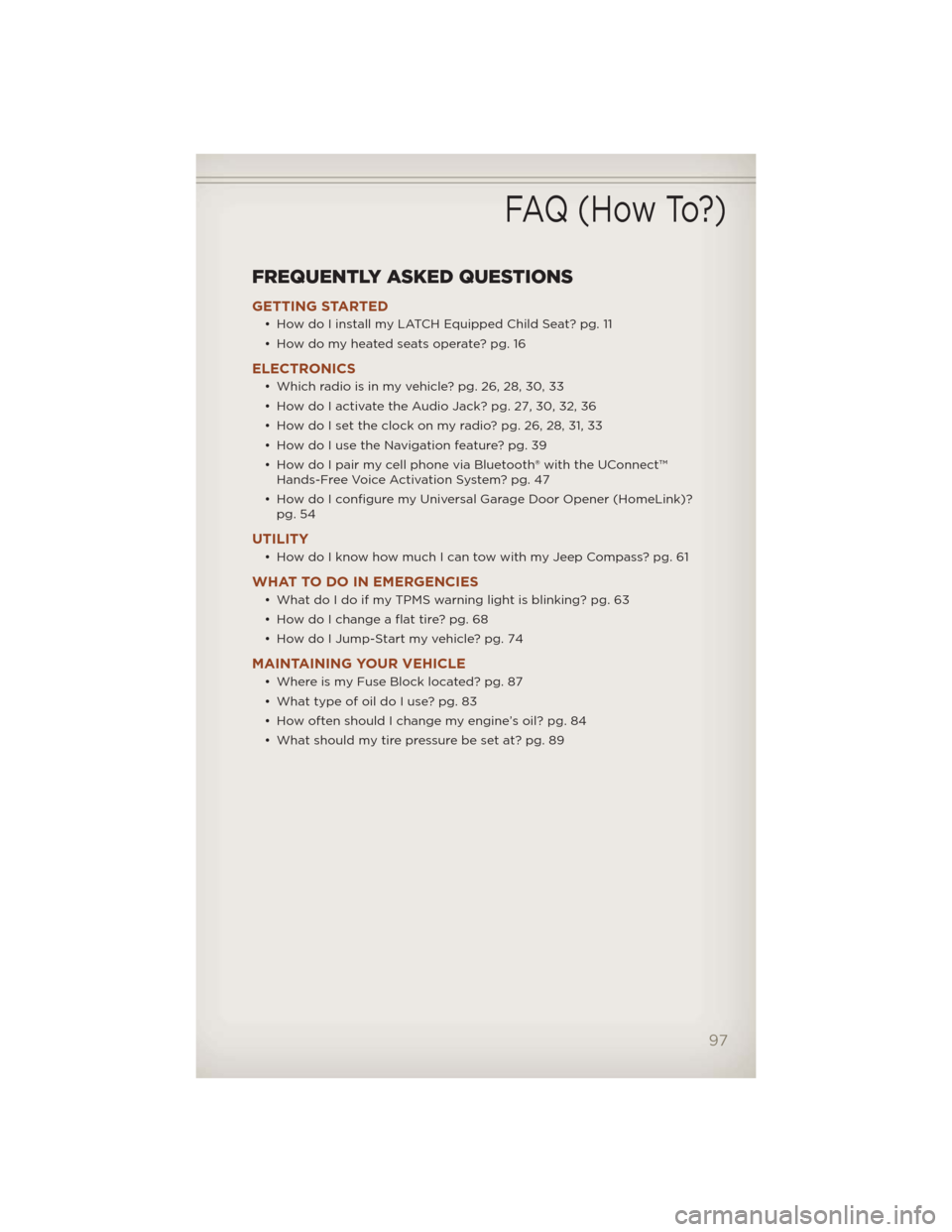
FREQUENTLY ASKED QUESTIONS
GETTING STARTED
• How do I install my LATCH Equipped Child Seat? pg. 11
• How do my heated seats operate? pg. 16
ELECTRONICS
• Which radio is in my vehicle? pg. 26, 28, 30, 33
• How do I activate the Audio Jack? pg. 27, 30, 32, 36
• How do I set the clock on my radio? pg. 26, 28, 31, 33
• How do I use the Navigation feature? pg. 39
• How do I pair my cell phone via Bluetooth® with the UConnect™
Hands-Free Voice Activation System? pg. 47
• How do I configure my Universal Garage Door Opener (HomeLink)?
pg. 54
UTILITY
• How do I know how much I can tow with my Jeep Compass? pg. 61
WHAT TO DO IN EMERGENCIES
• What do I do if my TPMS warning light is blinking? pg. 63
• How do I change a flat tire? pg. 68
• How do I Jump-Start my vehicle? pg. 74
MAINTAINING YOUR VEHICLE
• Where is my Fuse Block located? pg. 87
• What type of oil do I use? pg. 83
• How often should I change my engine’s oil? pg. 84
• What should my tire pressure be set at? pg. 89
FAQ (How To?)
97